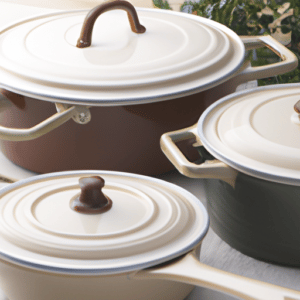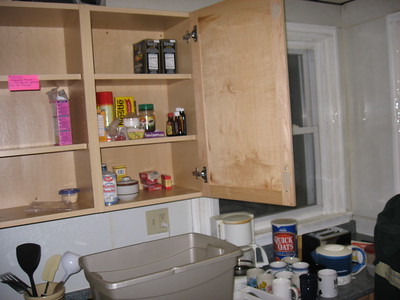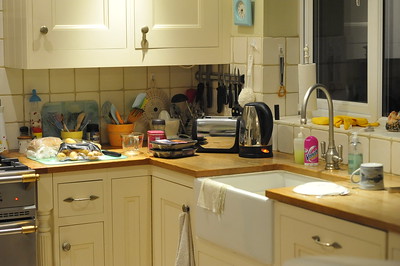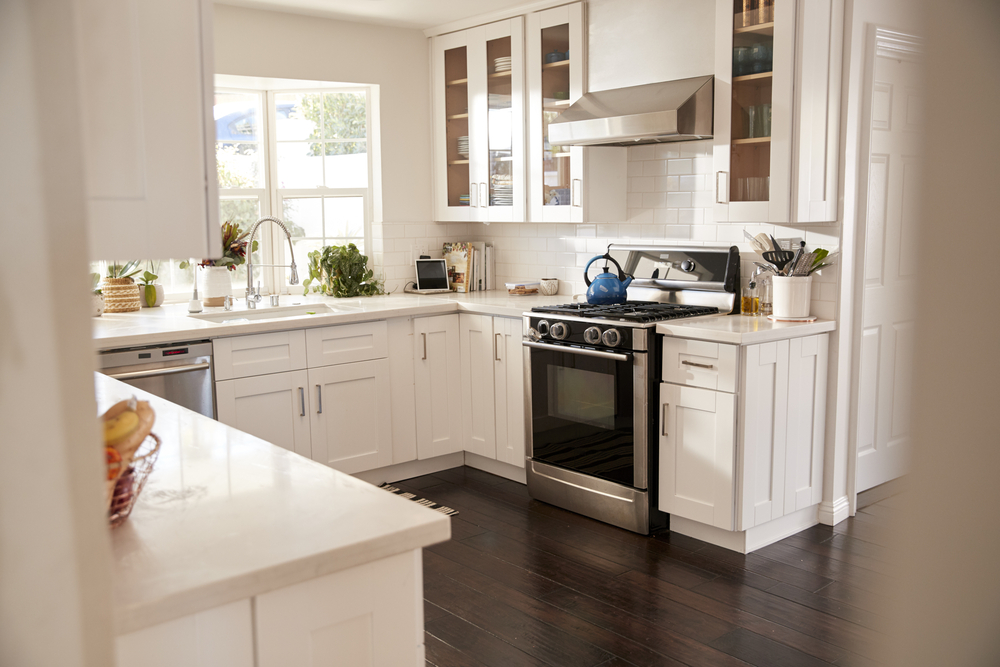Kitchen cupboards can easily become full and cluttered as they are an accessible space to put things away and close the door on. Have you experienced opening your cabinet doors only for items to come tumbling out?
The kitchen is also an area where you spend a lot of time in, so it is easy to store various objects that don’t necessarily belong there. For instance, there can’t be many of us who can say we don’t have an ‘everything drawer’ in the kitchen!
However, neglecting to organise your cabinets might result in wasted space, potentially losing food products because you can’t see them, or purchasing duplicate goods since you’re unaware of what is in the cupboard. Having a well-organised cupboard space also means that cleaning is much more straightforward.
Below, we have put together some easy tips and advice on how to organise kitchen cupboards.
Step-by-Step Guide on How to Organise Kitchen Cupboards
Step 1: Get Organised and Declutter
This step will prove to be so space-saving even in its own right! Taking everything out of your cupboards and sorting through them is essential. It will give you a clear idea of what you have, what you still need and what can be binned, given away or moved to a more suitable storage location.
Having boxes ready to place items in as you sort them so that you can easily deal with them is a great tip.
Before buying any nifty storage solutions for kitchen cupboards, this step should always be done. You could risk wasting money if you don’t know how much extra storage you need to start with.
Step 2: Clean Your Cupboards
When you have empty cabinets, take the opportunity to clean them thoroughly. First, clean out any crumbs or dust that has accumulated and then wipe them down thoroughly with a cloth or scouring pad using dish soap or any cleaning product you have under the kitchen sink, but if you prefer to avoid chemicals, baking soda can be used as a scrubbing agent.
Ensure that the cabinets are fully dry before moving on with the next steps, as any water left to sit on the wood may cause it to warp or become stained.
Lining the bases of your cabinets is also a good trick to use to protect the wood from becoming marked. You can simply use kitchen paper to do this, or you can cut down vinyl, cork or lining papers and slide them into the base of your cupboard. Placing scented sachets in the corners of cabinets is a nice way to introduce a fresh fragrance, as it is easy for cupboards that contain food items to become slightly fusty over time.
Step 3: Categorise Your Kitchen Cupboard Contents and Start Planning
Once you have emptied out all of your cupboards, sorted through them, and given them a thorough clean, you are ready to organise and plan the remaining contents.
If you are unsure of where to start with organising cupboards, then there are some easy first steps to follow:
Consumables From Cook and Dinnerware
It is usual to store food items separately in pots and pans, so this is an easy first step to take. If you separate any food items out, then you have your first two sets of contents to break down further.
Categorise Your Food Items
Taking your food items, you can then separate these out into different groups, such as canned goods, spice jars, baking items, baked goods, snack items and teas and coffees.
Begin to Group Cookware and Dinnerware Items
Separating your cookware items is where the function of your kitchen starts to come into play, and it is important to organise things in a way that makes sense to you.
You want your kitchen layout to contain storage spaces for items that you use frequently and group together. For instance, group pots and pans together, serving dishes, food preparation items like chopping boards, a knife block, plates and bowls and mugs and glasses. You want to achieve easy access to the things that you use most often and have them together in logical groupings.

Group Together With the Non-cookware Items
Kitchen cabinets also store things such as cleaning supplies, tea towels and other miscellaneous items such as anything that had made it into your ‘junk drawer’! It is just as important to find the right space for these items.
Once you have worked through categorising your cabinet contents, you are ready to move on to the next step.
Step 4: Plan Out Your Kitchen Storage
This step is all about how to best organise your kitchen cabinet space to make the most of the storage you have. This is also to keep things so that you have easy access to them, and their location makes sense to the way you use your kitchen.
It makes sense to plan out your kitchen cabinets to have things like food prep items stored near your worktop, mugs near your kettle and pans, pots and other cooking equipment near your hob.
When you have all of your kitchen items out of the cupboards, it is a great time to sort them into groups and stack them where you can see them so that putting them back is a quick and easy process. For example, group glassware together – from daytime drinking glasses to stemmed wine and champagne glasses -large and small plates and bowls, mugs, and occasion dinnerware and serving platters.
If your kitchen includes glass-fronted cupboard doors, consider what you want to be displayed within them, bearing in mind that what you choose will be visible. Things like a special china set or crystal glasses are a good choice here.
Work out the frequent paths you take in the kitchen and then assign things to those cabinets to avoid the frustration of having to go a long way for a frequently used item!
What to Store Where
In most kitchens, people have both upper and lower cabinets, and they lend themselves to different items, so here is a bit of advice on what to store where:
Upper Storage Space
Things that can easily break are often good for upper cabinets, such as wine glasses and mugs. If you have a special dining set, it might make sense to keep this in an upper cupboard too.
Allocating items above their corresponding workspace also makes good sense. For instance, food storage above your worktop where you do your food preparation is sensible. So you don’t have to keep making unnecessary journeys around your kitchen for items you regularly use.
Recipe books also make sense to store away behind cupboard doors, perhaps at the end of a row of kitchen cabinets, on the basis that you will probably be reaching for them less often than some other kitchen items.
Lower Storage

Lower kitchen storage lends itself to heavier or bulkier items and is the ideal place for things like kitchen appliances such as slow cookers, bread makers and casserole dishes. Items that you do not use that frequently can be stored away without using up valuable shelf space for smaller, more frequently used items. Not having large appliances out on a worktop saves valuable counter space for items that do need to be out, such as kettles and toasters.
Cleaning supplies can be kept in an under-sink cabinet if you have one, as there is usually a good amount of space under the kitchen sink. If you have chemical cleaning products, we recommend fitting this cupboard with a child safety lock if you have children or pets in your household. This will keep these products out of harm’s way.
Lower storage space is often deeper than upper cupboards, so it is a great place to keep large cooking dishes and pots and pans. Modern islands and under hobs storage are often made up of long and deep drawers. This is where you can keep such things, have crockery trays, and keep your cooking utensils handy for when you are cooking.
Pantry Storage Space
If you are lucky enough to have a pantry, this is a great place for food storage and leaves space for crockery and cooking equipment in your kitchen cabinets. If you have strong shelves installed, you can also keep small appliances in a pantry, freeing up kitchen space.
Storage Devices and Top Tips
Once you have categorised your kitchen cabinet contents and decided upon everything’s new location, you can give thought to how it will be stored.
It makes sense to store frequently used items at the front or on the lower shelves so that they are easily accessible. It is also an idea to label any food storage containers or even on the inside of cupboard doors. So, everyone in your household knows your system and can replace items correctly!

Storage Devices
At this stage, you can also consider using any space-saving devices to help ensure that there is no wasted space in your cabinets. There are many different types of kitchen cabinet organisers to choose from, but we have added a few below that we think every kitchen should include:
Shelves or Baskets on Runners
If you have been wondering how to organise food cupboards, then ire shelves or baskets that pull out on runners are fantastic for storing cans and spice jars. They come in many different widths to fit all shapes and sizes of cabinets. These are very useful if you have quite a narrow space, as it allows you to keep a lot of products in just a small area that would otherwise have been pretty inaccessible.
Pull-Out Corner Storage Organisers
Pull-out corner storage organisers are perfect for corner cabinets where items can disappear into the depths, never to be seen again! These storage devices swing away into the back of the corner cupboard, using what would otherwise be wasted space.
Utensil Trays
Utensil organisers are a great way of preventing drawers from becoming a tangle of serving spoons, spatulas and scissors. These trays have compartments where you can separate items out so that they are stored neatly, and you can fit far more in the drawer than if everything is loose.
Mug, Glass Hooks or Tree
Installing a row of hooks beneath upper units, or placing a mug tree on a worktop, are great ways to neatly store mugs without using up all of the space in one cabinet.
Plate Racks or Stackers
Racks or dish stackers are great for placing in deep drawers or cupboards and help you to neatly keep all of your plates easily accessible and together.
Pan Racks
Pans are some of the bulkiest items that you need to store in the kitchen, so if you have the space under one of your cupboards, you can place a pan rack and hang them from this. If you place the rack near your oven and hob, they are always accessible when you are cooking and can be easily hung back up after washing.
Cabinet Shelf Splitters
Other kitchen cupboards organising ideas include using a cabinet shelf made up of wire shelves that allow you to place things like plates underneath it and bowls on top. It provides another layer of shelf space for everyone in your cupboard.
Maintaining Order
Regularly tidying kitchen cupboards is a great way to ensure they stay organised and don’t go back to spaces where anything could lurk! Aim to have a thorough clean twice a year, removing things that may have gone past their sell-by date or that you haven’t used in this timescale and have no intention of doing so.

Labelling cupboards and storage boxes will allow everyone in the household to know what should be kept where and will help things go back to their correct place once used and prevent chaos from ensuing again!
Making decisions about the most logical layout for items is not a one-time activity. It can be revisited over time as you use your kitchen or if things change and you need certain items more often than before. If you take more than a few seconds to reach and access items, your kitchen layout may not be working correctly for you. This should be changed around to make it more convenient for you.
Enjoy a Clean and Uncluttered Kitchen
We hope that all of the steps and top tips we have provided have helped you formulate a plan for how to organise kitchen cupboards well since we know that this can feel like a bit of an overwhelming task to take on!
The key is to fully clear everything out and make sure that anything you never intend to use is either donated to charity, recycled or thrown away, and the remaining items are fully sorted. Putting items into logical groups will help you work out the best layout for your kitchen cupboards and will help you to put things back away quickly.
A well-organised set of kitchen cupboards makes your kitchen an enjoyable space to spend time in and avoids frustration, so take on the challenge today!

